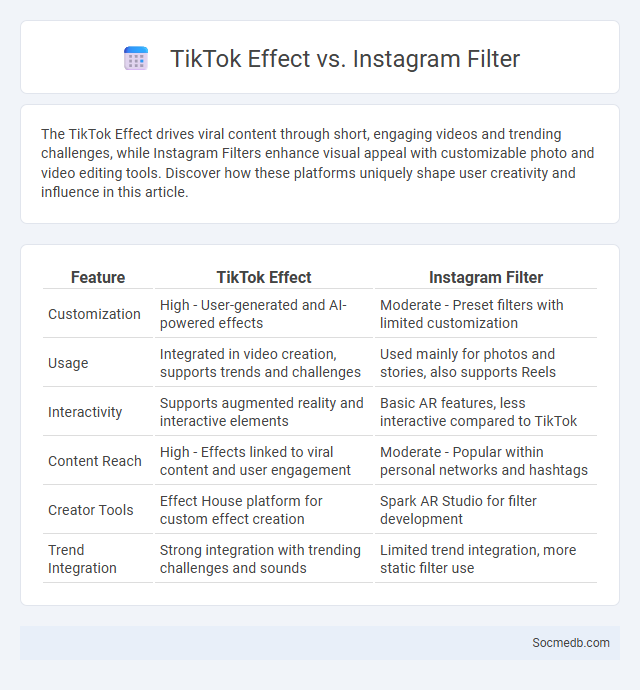
Photo illustration: TikTok Effect vs Instagram Filter
The TikTok Effect drives viral content through short, engaging videos and trending challenges, while Instagram Filters enhance visual appeal with customizable photo and video editing tools. Discover how these platforms uniquely shape user creativity and influence in this article.
Table of Comparison
| Feature | TikTok Effect | Instagram Filter |
|---|---|---|
| Customization | High - User-generated and AI-powered effects | Moderate - Preset filters with limited customization |
| Usage | Integrated in video creation, supports trends and challenges | Used mainly for photos and stories, also supports Reels |
| Interactivity | Supports augmented reality and interactive elements | Basic AR features, less interactive compared to TikTok |
| Content Reach | High - Effects linked to viral content and user engagement | Moderate - Popular within personal networks and hashtags |
| Creator Tools | Effect House platform for custom effect creation | Spark AR Studio for filter development |
| Trend Integration | Strong integration with trending challenges and sounds | Limited trend integration, more static filter use |
Understanding TikTok Effects: Definition and Features
TikTok effects are augmented reality (AR) filters and visual enhancements that transform videos with dynamic animations, color adjustments, and interactive elements. These effects enrich user content by enabling creative expression and increasing viewer engagement through features like face tracking, background changes, and special effects. Understanding how to leverage TikTok effects can elevate Your content's appeal and maximize reach on the platform.
Instagram Filters Explained: What Sets Them Apart
Instagram filters enhance photos and videos by applying unique algorithms that adjust color balance, contrast, and saturation to create visually appealing effects. These filters differ from basic editing tools by combining multiple enhancements with artistic overlays or augmented reality features, offering users customizable and immersive experiences. Advanced machine learning and AI technology enable dynamic effects that adapt to facial recognition and environmental lighting, setting Instagram filters apart in the social media landscape.
TikTok Effect vs Instagram Filter: Core Differences
TikTok Effect offers dynamic, AI-driven augmented reality experiences that encourage user interaction through trending challenges and participatory content, while Instagram Filters primarily enhance photos with static or subtle motion effects focused on aesthetic appeal. TikTok's algorithm promotes viral content by leveraging these effects to boost engagement and creator visibility, contrasting with Instagram's emphasis on polished visuals for personal branding. The core difference lies in TikTok's effect-driven, community-centric content creation versus Instagram's photo enhancement tools designed for curated, visually consistent profiles.
User Experience: Ease of Applying Effects and Filters
Social media platforms enhance user experience by offering intuitive interfaces for applying effects and filters, enabling seamless creativity and personalization. Advanced algorithms and real-time previews allow users to effortlessly adjust aesthetics, improving engagement and satisfaction. The integration of AI-powered suggestions further simplifies content creation, making visually appealing posts accessible to all skill levels.
Creative Possibilities: Customization on TikTok and Instagram
TikTok and Instagram offer extensive creative possibilities through customization features like filters, AR effects, and music integration, allowing you to tailor content uniquely to your style. These platforms support video editing tools, interactive stickers, and personalized hashtag challenges, enhancing user engagement and content discoverability. Leveraging these customization options can significantly amplify your social media presence and audience connection.
Popularity and Trends: What’s Viral on Each Platform
TikTok dominates viral trends with short, engaging videos that often spark global challenges and memes. Instagram leverages Stories, Reels, and influencer content to quickly boost popularity through highly visual and interactive formats. On Twitter, real-time conversations and trending hashtags drive viral moments centered around news, entertainment, and social issues.
Brand and Influencer Use: Marketing with Effects and Filters
Brands leverage social media marketing by collaborating with influencers who utilize effects and filters to enhance visual storytelling and audience engagement. These customized filters create immersive brand experiences that boost recognition and reinforce brand identity across platforms like Instagram and TikTok. Influencer-driven campaigns using branded effects increase reach and conversion rates by appealing to younger, tech-savvy demographics.
Community Engagement: How Users Interact with Effects
Social media platforms enhance community engagement by enabling users to interact with effects through likes, comments, and shares, fostering real-time communication and collaboration. Interactive features such as augmented reality filters and reaction buttons amplify user participation, creating dynamic digital experiences that strengthen social connections. Data shows that posts featuring interactive effects receive up to 30% higher engagement rates, highlighting their impact on online community building.
Technical Aspects: AR Technology Behind Effects and Filters
Augmented Reality (AR) technology in social media platforms powers dynamic effects and filters by combining computer vision, depth mapping, and machine learning algorithms to track facial movements and environmental elements in real-time. Advanced AR frameworks like ARKit and ARCore enable precise placement and interaction of virtual objects within your camera feed, enhancing user engagement through immersive experiences. Your device's GPU acceleration and sensor data integration ensure seamless performance and responsiveness of these digital overlays during live video sessions.
Future of Social Media Visuals: Effects and Filters Evolution
The future of social media visuals centers on advanced effects and filters powered by artificial intelligence and augmented reality, enabling hyper-personalized and immersive content experiences. Innovations in real-time facial recognition and 3D mapping will transform your posts, allowing seamless integration of virtual elements that enhance emotional expression and creativity. Enhanced filter algorithms will not only improve aesthetic appeal but also analyze user engagement metrics to deliver optimized visual content tailored to audience preferences.
 socmedb.com
socmedb.com